
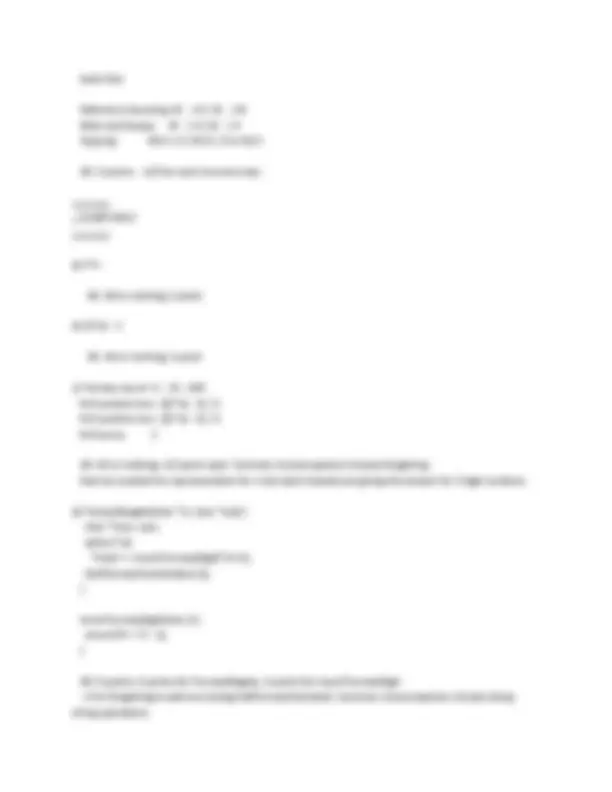
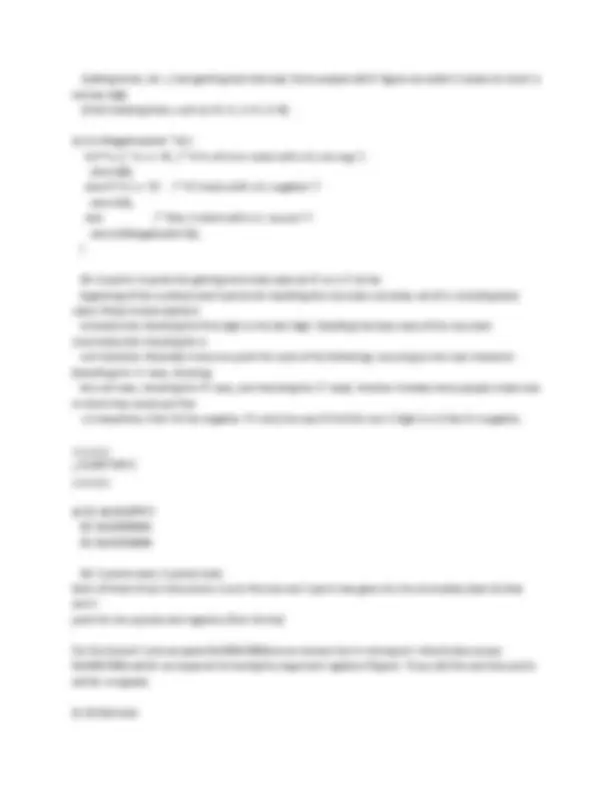
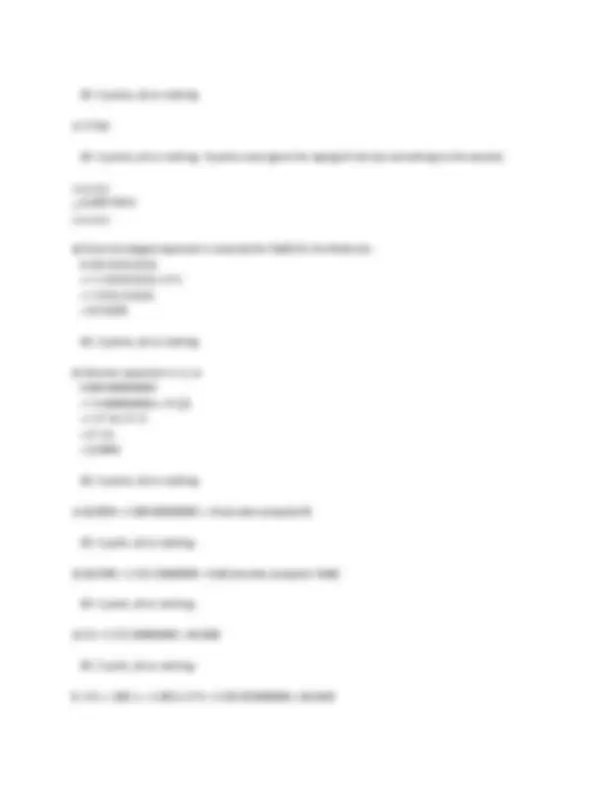
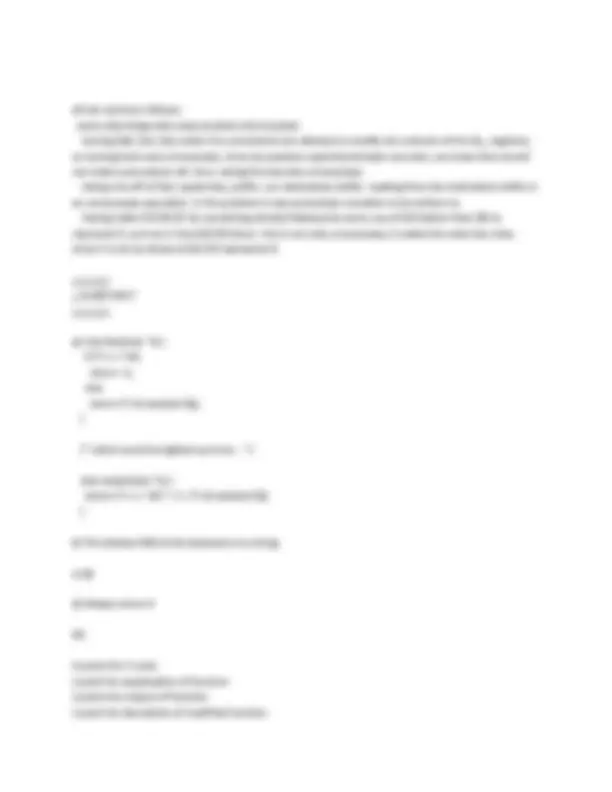
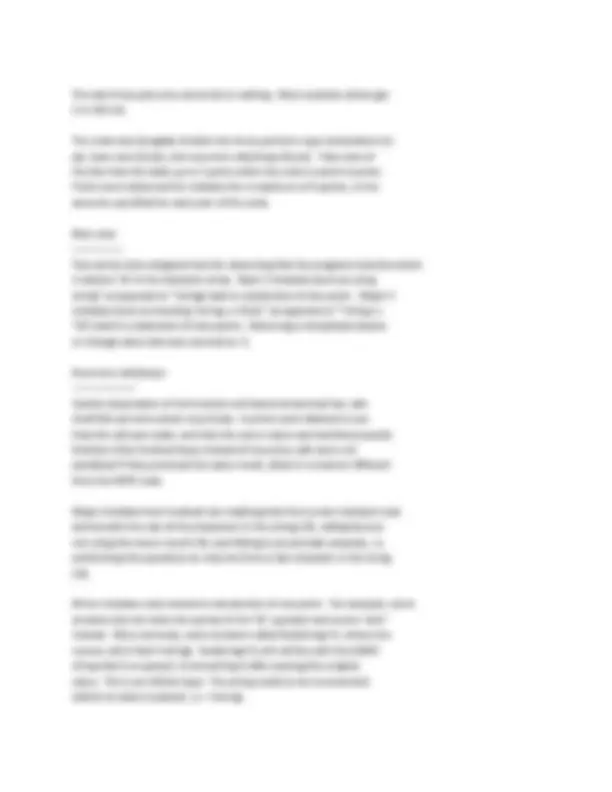
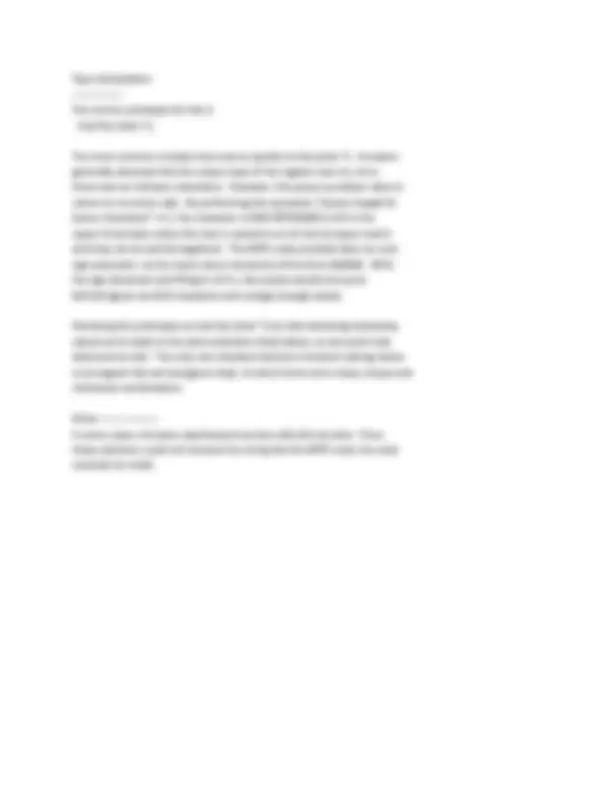


Study with the several resources on Docsity

Earn points by helping other students or get them with a premium plan


Prepare for your exams
Study with the several resources on Docsity

Earn points to download
Earn points by helping other students or get them with a premium plan
Community
Ask the community for help and clear up your study doubts
Discover the best universities in your country according to Docsity users
Free resources
Download our free guides on studying techniques, anxiety management strategies, and thesis advice from Docsity tutors
Solutions to various computer science quiz questions. Topics covered include converting characters to hex values, understanding ieee float representation, analyzing memory allocation techniques, and decrypting simple encryption algorithms.
Typology: Exams
1 / 10

This page cannot be seen from the preview
Don't miss anything!







;; 2005Sp CS61C Midterm ;; ;;;;;;;;;;;;;;;;;;;;;;;;;;
GS = "Grading Standard"
;;;;;;;;;;;;; ;; QUESTION 1 ;;;;;;;;;;;;;
a) "#One" is in a register. Mapping the characters, one-by-one, into hex values, we consult the table to find '#' => 0x23, 'O' => 0x4f, 'n' => 0x6e, and 'e' => 0x65. Concatenating them together yields 0x234f6e4f.
GS: 1 point. Half credit if you converted from character 'o' rather than 'O'.
Converting them to an instruction involves mapping the word to a binary representation, breaking it up into fields based on the leftmost 6-digit opcode, and translating each field into a value.
0b 0010 0011 0100 1111 0110 1110 0100 1111 The leftmost 6 opcode bits are "00 1000", so it's an addi I-type inst. This has 4 fields of length [6 5 5 16], so breaking up the bits we get = 00 1000 | 1 1010 | 0 1111 | 0110 1110 0100 1111 = addi | rs=$26 | rt=$15 | 0x6e4f = addi | rs=$k0 | rt=$t7 | 0x6e4f = addi $t7,$k0,0x6e4f
GS: 1 point. No deduction if you lost the half point in the first part of the question and correctly converted that answer into an instruction. Half credit if you flipped $t7 and $k0.
b) The number of exponent bits controls the range of the IEEE float and the number of significant bits controls the precision. Thus, if we hand some exponent bits to the significand, the pro will be "reduced range", and the con will be "increased precision".
GS: 2 points. 1 point for each box. All or nothing.
Common Confusion: Reversing the answers.
c) To convert the pseudoinstruction "bfz $a0 done" to TAL, we have to detect either 0, represented as 0x80000000 (-0) or 0x00000000 (0). One clever way to do this is to shift the word left by one place which would push that topmost bit (1 or 0) into the bitbucket and insert a 0 on the right. Then we simply need to test whether that resulting value is all zeros. We use our temporary register $at:
sll $at,$a0, beq $at,$0,done
GS: 2 points. Lots of interesting answers here... Anything that worked as was straight forward enough for me to figure out got full credit. Basically, 1 point for acknowleding that there are two zeros and 1 point for correctly branching on zero.
Common Confusion: Forgetting that there are two zeros and just using a BEQ $a0, $0, done. Using the ADDI instruction in ways that didn't make sense. Trying to ANDI $at, $a0, 0x7FFFFFF (doesn't work because immediates can't be that big) Shifting way, way too much (I saw some solutions with as many as 12 seperate shift instructions.)
d) The Buddy System and Slab Allocator are similar in that they use their particular technique to handle small requests but the K&R for large memory requests. Each introduces internal fragmentation, and K&R introduces external fragmentation, so the answers are:
Buddy System : causes both types Slab Allocator : causes both types K&R (Free List Only) : causes external only
GS: 2 points. 1 point for one incorrect answer, 0 points for 2 or 3 incorrect answers
e) Since Copying only uses half of the memory at any one time, "full" means M/2. The others use all the memory, so "full" means "M". After GCing, in the best case, all systems are able to clear out all unused data, so the least space the data would take up is 0 for all. The most space their data could take up after GCing is the same as the first column, if the GCer didn't recover any unused space. Wasted space? Reference counting cannot handle circular references, so at worst the entire memory could be filled (M) with such a structure. The table
(calling strlen, etc...) and getting lost that way. Some people didn't figure out what it means to invert a ternary digit (tried rotating them, such as: 0->1, 1->2, 2->0).
e) int isNegative(char in) { if (!in || in == '0') / If it's all 1s or starts with a 0, not neg / return(0); else if (in == '2') /* If it starts with a 2, negative / return(1); else / Else, it starts with a 1, recurse */ return(isNegative(in+1)); }
GS: 6 points: 2 points for getting the trivial cases (a '0' or a '2' at the beginning of the number) and 4 points for handling the recursion correctly--all of it, including base cases. Many misconceptions included only checking the first digit or the last digit. Handling the base case of the recursion incorrectly (not checking for a null character. Basically it was one point for each of the following: recursing to the next character (handling the '1' case, checking the null case, checking the '0' case, and checking the '2' case). Another mistake some people made was to think they could just find a 2 anywhere, then it'd be negative. It's only the case if the first non-1 digit is a 2 that it's negative.
;;;;;;;;;;;;; ;; QUESTION 3 ;;;;;;;;;;;;;
a) 01: 0x2222FFFC 02: 0x1040000A 03: 0xAC
GS: 2 points each, 6 points total. Each of these three instructions is and I-format and 1 point was given for the immediate (last 16 bits) and 1 point for the opcode and registers (first 16 bits)
For the branch I only accepted 0x1040 0000a as an answer but in retrospect I should also accept 0x1002 000a which corresponds to having the argument registers flipped. If you did this and lost points ask for a regrade.
b) 16 Exbirules
GS: 2 points, all or nothing
c) 2 Tebi
GS: 2 points, all or nothing. 0 points were given for saying 41 bits (or something to this extent).
;;;;;;;;;;;;; ;; QUESTION 4 ;;;;;;;;;;;;;
a) Since the largest exponent is reserved for NaN/inf, the fields are: 0 110 111111111 = + 1.111111111 x 2^ = + 1111. = 15 63/
GS: 3 points, all or nothing.
b) Denorm exponent is -2, so 0 000 000000001 = + 0.000000001 x 2^(-2) = + 2^-9 x 2^- = 2^- = 1/
GS: 3 points, all or nothing.
c) 0x1000 = 1 000 00000000 = -0 (we also accepted 0)
GS: 1 point, all or nothing.
d) 0x1F00 = 1 111 10000000 = NaN (we also accepted -NaN)
GS: 1 point, all or nothing.
e) inf = 1 111 00000000 = 0x1E
GS: 1 point, all or nothing.
f) -4.5 = -100.1 = -1.001 x 2^2 = 1 101 001000000 = 0x1A
lbu $t0, 0($a0) # beq $t0, $0, done # lw $t1, 0($a1) # addu $t2, $t0, $t1 # sw $t2, 0($a2) # addiu $a0, $a0, 1 # addiu $a1, $a1, 4 # addiu $a2, $a2, 4 # j encryptThis # done: sw $0, 0($a2) # jr $ra #
GS: control [5]: included the lbu, beq, j instructions. [2]: lbu. both lbu and lb were accepted; the fact that the ascii values were in the range 0- indicated that it did not matter. 1 point was deducted for using lw; 2 points were deducted for neglecting to dereference cleartext, and thus testing whether the cleartext pointer was null. [3]: beq, j. a central part of this problem was setting the loop control to traverse to allocated arrays. because the problem explicitly stated to avoid recursion, a recursive call [jal] was not given any points.
encoding function [2]: included the lw, addu, sw instructions. [2]: the main body of the code performed dereferences of the arrays, sums, and then a store back into an array. the lw, addu, sw are a fairly direct translation of that body.
increment [2]: included the addiu instructions. [2]: the c call of encrypt this relied on the incrementation of the arguments. again, the addiu are a fairly direction translation of that process. 1 point was deducted for using an incorrect stride for any of the increments. note the argument types listed in the comments above provide the array stride lengths. 1 point was also deducted for having incorrect arguments- for instance, incrementing some register but writing into a different register.
epilogue [1]: included the sw, jr instructions. [1]: the epilogue consisted of the base case of zero terminating cyphertext_buffer and the return to caller. any omission or error was a 1 point deduction.
as a note of subtlety, the correct operators for all of the additions were the 'unsigned' variants [more accurately, the 'do not signal overflow' variants]. c does not signal overflow exceptions and will always compile its additions to these 'unsigned' variants. this error was marked, but no points were deducted, as this was a common error, and had not been an emphasis of the class. any of the additions in this problem could have 'overflowed', that is, could have crossed the boundary from 0x7FFFFFFF to 0x80000000, for which the 'signed' variants would cause an exception.
all too common silliness: some silly things that many students did included: storing $a0, $a1, $a2, andor $ra. procedures are allowed to modify the contents of the $a_ registers, so storing them was unnecessary. since the problem explicitly forbade recursion, we know that we will not make a procedure call. thus, saving $ra was also unnecessary. doing a lw off of $a2, cyphertext_buffer, our destination buffer. reading from the destination buffer is an unnecessary operation. in this problem it was exclusively a location to be written to. having 'addu $t9 $0 $0' (or something similar) followed by some use of $t9 (rather than $0) to represent 0, such as in 'beq $t0 $t9 done'. this is not only unnecessary; it makes the code less clear, since it is not as obvious that $t9 represents 0.
;;;;;;;;;;;;; ;; QUESTION 7 ;;;;;;;;;;;;;
a) char foo(char s) { if (s == '\0') return -1; else return (*s & ander(s+1)); }
/* which could be tighted up to be... */
char ander(char s) { return (s == '\0')? -1 : (*s & ander(s+1)); }
b) The bitwise AND of all characters in a string.
c) @
d) Always return 0
GS:
6 points for C code 1 point for explaination of function 2 points for output of function 1 point for description of modified function.
The correct prototype for foo is char foo (char *);
The most common mistake here was to specify int foo (char *). Students generally assumed that the output type of the register was int, since there was no indicator elsewhere. However, this poses a problem when it comes to recursive calls. By performing the operation "(some integer) & (some character)" in C, the character is SIGN EXTENDED to fill in the upper three bytes when the char is casted to an int (so the types match and they can be and'ed together). The MIPS code provided does no such sign extension- so the result return should be of the form 0x000A. With the sign extension and filling in of 1's, the output would end up as 0x111A (given an ASCII character with a large enough value).
Declaring the prototype as char foo (char *) but also delcaring temporary values as int leads to the same problems listed above, so one point was deducted as well. The only non-standard solutions involved casting values to (unsigned int) and (unsigned char), of which there were many unique and interested combinations.
Other ----------------- In some cases, the base case/loops/recursive calls did not exist. Since these solutions could not traverse the string like the MIPS code, the code received no credit.